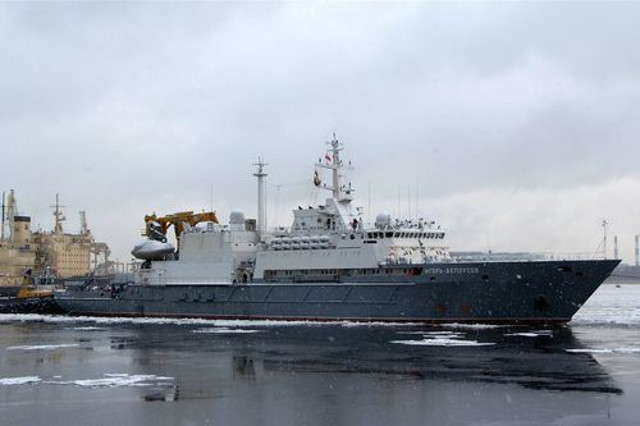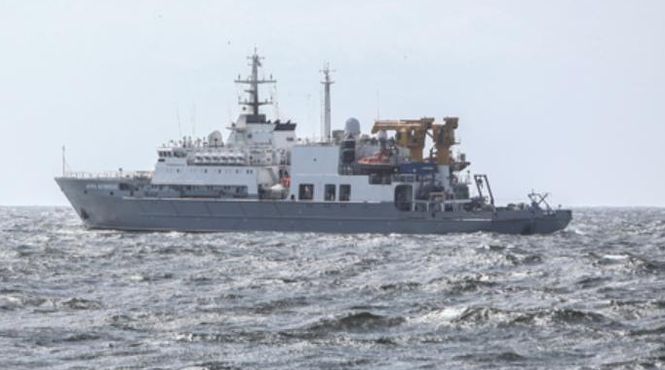The rescue vessel Igor Belousov, the first in its class, has become operational with the Russian Navy, a TASS correspondent reported from the ceremony at the Admiralty Wharves Shipyard on Friday (Dec 25). The ceremony was attended by Admiralty Wharves CEO Alexander Buzakov, Navy Deputy Commander-in-Chief for Armament Vice-Admiral Viktor Bursuk and representatives of the defense industry.

"Thank you very much for this New Year gift, which you have made for the Russian Navy. The Fleet has been waiting for this vessel for a long time. During its construction, all the advanced ideas accumulated over years were used," Bursuk said, addressing the shipbuilders.
The rescue ship Igor Belousov will join Russia’s Pacific Fleet. The rescue vessel has been included in the Russian Navy’s emergency and rescue group with its base in Vladivostok. The Fleet is considering continuing the construction of a series of vessels of this class. The search and rescue vessel Igor Belousov was built on order from the Russian Defense Ministry. It was laid down in December 2005. The rescue vessel was designed by the Almaz Central Marine Design Bureau (Project 21300) and is intended to rescue crews of distressed submarines immobilized on the seabed or floating on the surface.

The vessel is also designed to provide life support for the crew of the submarine being rescued. The lead rescue ship Igor Belousov that has joined the Russian Navy on Friday is worth over 10 billion rubles ($143 million), Navy Deputy Commander-in-Chief for Armament, Vice-Admiral Viktor Bursuk said. The Russian Navy intends to send the rescue vessel Igor Belousov to its base in Vladivostok in the Russian Far East "across all the oceans" rather than via the Northern Sea Route, Bursuk said. "A final route for the ship has not yet been approved but most likely it will run across all the oceans rather than via the Northern Sea Route to check the vessel in various latitudes. We plan to start the transfer in the spring of 2016," Bursuk said.
New ships in the Russian Navy New ships will also arrive for the Russian Navy in the first quarter of 2016. Specifically, the Black Sea Fleet will receive the Admiral Grigorovich-class frigate, the first out of six frigates of this series, which will be armed with the newest Kalibr cruise missiles.
In May, the Russian Navy will receive the mine sweeper Alexander Obukhov featuring the first ever full-size composite hull. Until the end of the year, the multipurpose strike frigate Admiral Gorshkov incorporating stealth technologies will become operational in the Russian Navy. A source in the defense and industrial sector told TASS on Friday that "a large volume of trials lies ahead for precision-guided weapons."
Russia’s state armaments program to 2020 stipulates 4.7 trillion rubles ($67 billion) in expenditures on the Navy’s upgrade. Data from public sources suggest there were 209 combat ships and 72 submarines, including 50 nuclear-powered underwater cruisers, in the Russian Navy as of July 2015. The Russian Navy will receive seven surface ships and two submarines in 2016. According to the budget projections available as of October, appropriations for the National Defense spending item in 2016 may total 3.1 trillion rubles ($44.5 billion), i.e. 25.5 billion rubles ($360 million) more than in 2015. As Russian Defense Minister Sergei Shoigu said in December, the Russian Army is 92% staffed compared with 90.5% in late 2014.
The number of contract servicemen has risen by 10% to 352,000. As many as 384,000 contract servicemen are expected to serve in the Russian Armed Forces in 2016 and the total number of servicemen will reach 93% of their full strength. Russia’s nuclear triad has been 55% supplied with modern weaponry in 2015. Russia’s Strategic Missile Force has received 35 ICBMs, nine modernized bombers and two nuclear-powered submarines.
Russia has set up six missile regiments with ballistic missiles and they will be joined by another five such regiments in 2016 while the Russian Aerospace Force will receive 16 strategic bombers. As a result of the Russian Armed Force’s swift rearmament, Russia has produced 15,800 types of new weapons and combat hardware over the past three years while expenditures on the state defense procurement program have risen by 2.6 times.
Source: tass.ru